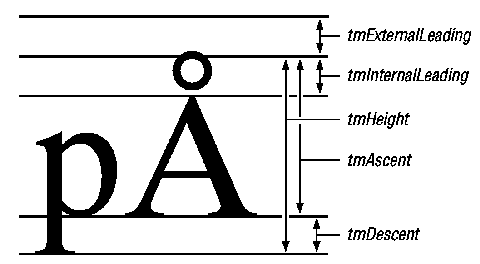
Line spacing, like character size, is typically specified in points. If a 10-point font is displayed with 12-point line spacing, this is abbreviated as “10/12” and is called “ten on twelve” line spacing.
Following are some of the line and intercharacter measurements an application can affect or query when it creates a font:
| Measurement | Description |
| External leading | Specifies the space between rows of text. External leading is not part of the character cell. When the internal leading for a font does not contain parts of characters, the apparent line spacing is the external leading plus the internal leading. Windows does not support negative values for external leading. |
| Internal leading | Specifies the difference between the height of the character glyphs for a font (the font's em square) and the height of the character cell for a font. Applications use internal leading to determine the point size for a font; the point size is the height of the character cell minus its internal leading. Some applications have used internal leading incorrectly; specifically, internal leading is not strictly reserved for diacritical marks, nor should it be used as the space to be removed from the first line on a page. |
| Overhang | Specifies a characteristic of some glyphs that occupy the same horizontal space as adjacent glyphs. All of the characters in most italic fonts use overhangs to keep the characters relatively close together—for example, in the italic word Is, the top part of the letter “I” is directly over the bottom of the letter “s.” |
| Pitch | Specifies the general type of horizontal character spacing. A font can have either fixed or variable pitch. The character cells in a fixed-pitch font are all the same size, but in a variable-pitch font they vary depending on the width of the glyph. Another term for a fixed-pitch font is a monospace font. |
The external leading for a font is specified by the designers of the font. The concept of internal leading is specific to Windows.
The following figure shows internal and external leading and their relationship to the height of a font. The names beginning with the letters “tm” are members of the TEXTMETRIC structure.
